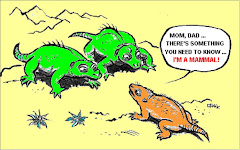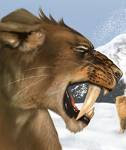Hello 7th graders,
Why is an elephant so big? Why does a snake have no legs? Why do some fish have bright colors? Did you ever wonder how everything on earth became what you see today?
In fact, whether it's a mammal, fish, bird, or reptile nothing started out in the form in which it exists today. How the creatures in these groups changed over millions of years, seen in the geologic timeline, is called the story of evolution. In your textbook you can also learn about the evidence of evolution. While studying evolution, you will learn about Charles Darwin (video) and about terms such as adaptation, natural selection, and extinction (video).
PART I DIRECTIONS: Library Research
For your topic, you have selected a modern creature from one of the four categories. Use the subtopics traits, habitat, and ancestors to explore your topic in library print materials, specifically nonfiction books and The World Book Encyclopedia. You must always cite your sources with the MLA forms and use them to create a "Works Cited" list for your final project. Citing sources and taking good notes instead of copying will prevent plagiarism.
PART II DIRECTIONS: Internet Research
With the geologic timeline as your guide, locate four of your modern creature's ancestors in different time periods to learn how your creature evolved over time. Using the Web links below, look up each ancestor. Write traits that describe their body, food, and habitat on the special chart. The traits will be your notes that you'll use to write a paragraph about each ancestor. *For this project, you are allowed to use Wikipedia and Freepedia, due to easy access to information and pictures.
Mammals
Horse
A. Locate four horse ancestors from four different time periods:
The Stages of Equus Development
The Evolution of the Horse
Horse Evolution
B. If you need help, just choose from this link, as well as more links below:
Eohippus also called hyracotherium and picture
Mesohippus and facts and picture
Merychippus and here with picture
Dinohippus and picture and click the links in Part A.
Cats
A. Locate four cat ancestors in any of these Web sites:
Cats from ancient times
Origin of the Domestic Cat
B. If you need help, just click the links below:
Smilodon (saber-toothed cats)
Miacids and picture
Dinictis and facts and picture
Cave lion facts are below the fossils or click for more facts
Modern cat: Use the notes from your research packet.
Elephant evolution tree (cladogram)
Elephant fossil evolution chart
B. If you need help, just click the links below:
Moeritherium
Palaeomastodon
Mastodon
Gomphothere (including Primelephas species)
Modern elephant: Use the notes from your research packet.
Whales
A. Locate four whale ancestors from four different time periods:
National Geographic's "Evolution of Whales"
B. If you need help, just click the links below:
Pakicetus, (land) and picture
Ambulocetus (sea-land) called "walking whale"
Rodhocetus
Basilosaurus
Elephant fossil evolution chart
B. If you need help, just click the links below:
Moeritherium
Palaeomastodon
Mastodon
Gomphothere (including Primelephas species)
Modern elephant: Use the notes from your research packet.
Whales
A. Locate four whale ancestors from four different time periods:
National Geographic's "Evolution of Whales"
B. If you need help, just click the links below:
Pakicetus, (land) and picture
Ambulocetus (sea-land) called "walking whale"
Rodhocetus
Basilosaurus
Modern whales: Use the notes from your research packet.
Fish
Fish
A. Locate four fish ancestors from four different time periods:
Evolution of Fish
Models of "Prehistoric Fish"
B. If you need help, just click the links below:
Agnatha (jawless fishes)
Acanthodians (jawed fishes)
Placoderms (jawed fishes)
Osteichthyes (bony fishes)
Modern fish: Use the notes from your research packet.
Fish
A. Locate four fish ancestors from four different time periods:
Evolution of Fish
Models of "Prehistoric Fish"
B. If you need help, just click the links below:
Agnatha (jawless fishes)
Acanthodians (jawed fishes)
Placoderms (jawed fishes)
Osteichthyes (bony fishes)
Modern fish: Use the notes from your research packet.
Sharks
A. Locate four shark ancestors from four different time periods:
Extinct Sharks
B. If you need help, just click the links below:
Cladoselache and fossil and quick description
Stethacanthus and facts and picture
Orthacanthus and picture and description
Megalodon and facts and picture
Modern sharks: Use the notes from your research packet.
Birds
A. Locate four bird ancestors from four different time periods:
Enchanted Learning bird evolution ancestor links
Click Early Birds in the left menu and choose four
A. Locate four shark ancestors from four different time periods:
Extinct Sharks
B. If you need help, just click the links below:
Cladoselache and fossil and quick description
Stethacanthus and facts and picture
Orthacanthus and picture and description
Megalodon and facts and picture
Modern sharks: Use the notes from your research packet.
Birds
A. Locate four bird ancestors from four different time periods:
Enchanted Learning bird evolution ancestor links
Click Early Birds in the left menu and choose four
B. If you need help, just click the links below:
Archaeopteryx
Sinosauropteryx
Caudipteryx
Unenlagia
Modern birds: Use the notes from your research packet.
Reptiles
Background information: Evolution of Reptiles
Choice 1: explore reptile evolution:
Before reptiles: labyrinthodonts (amphibian)
First reptile: hylonomus and scroll down for easy facts
Early reptiles: dimetrodon (example of pelycosaur)
Middle reptiles: tyrannosaurs (dinosaur from the diapsid group)
Modern reptiles: Use the notes from your research packet.
Choice 2: explore reptile diversification:
Land: crocodilians example: deinosuchus and picture
Land: early turtle example: archelon and picture
Archaeopteryx
Sinosauropteryx
Caudipteryx
Unenlagia
Modern birds: Use the notes from your research packet.
Reptiles
Background information: Evolution of Reptiles
Choice 1: explore reptile evolution:
Before reptiles: labyrinthodonts (amphibian)
First reptile: hylonomus and scroll down for easy facts
Early reptiles: dimetrodon (example of pelycosaur)
Middle reptiles: tyrannosaurs (dinosaur from the diapsid group)
Modern reptiles: Use the notes from your research packet.
Choice 2: explore reptile diversification:
Land: crocodilians example: deinosuchus and picture
Land: early turtle example: archelon and picture
Air: pterosaurs and picture
Sea: plesiosaurs, ichthyosaurs, mosasaurs
Modern reptiles: Use the notes from your research packet.
Amphibians
Labyrinthodonts
Lobe-finned fish
PART III DIRECTIONS: Create a PowerPoint
Modern reptiles: Use the notes from your research packet.
Amphibians
Labyrinthodonts
Lobe-finned fish
PART III DIRECTIONS: Create a PowerPoint









No comments:
Post a Comment